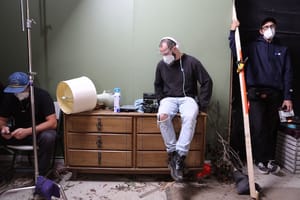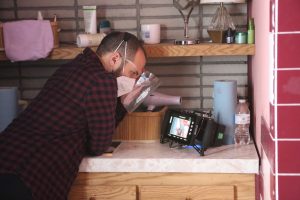
In making his feature film debut We Need to Do Something, director Sean King O’Grady struggled with when to follow his original vision, and when to compromise. The film, starring Sierra McCormick (The Vast of Night), Vinessa Shaw (Hocus Pocus) and Pat Healy (The Inkeepers), follows a family who become trapped after a storm. Soon the family’s teenage daughter, Melissa, realizes that she and her girlfriend may have had something to do with the horrors that threaten them all. In this piece, O’Grady — who has also produced films including last year’s Sundance darling The Assistant — shares what he learned about blocking, setups — and making adjustments.
This is a story about embracing reality — sticking to your vision, obsessing over details, but not letting what you thought would be your movie get in the way of the conditions the universe presents you with.
In the midst of pandemic-mania 2020, a bunch of crazy people decided to join me in Michigan to make an extremely contained movie, while living in a self-imposed “bubble” consisting of our set, and our hotel. For over a month, no one would see the light of day. Miraculously, we all survived without murdering each other, and that movie has now been released by IFC, and is called We Need to Do Something.
But let’s back up a little… During pre-production, the incredible cinematographer Jean-Philippe Bernier and I spent a week shot-listing every scene in the movie. We were psychotically organized. Because most of our movie takes place in one location, a bathroom, we matched our spreadsheet shotlist to an overhead diagram of the location — for every single shot. We knew the motivation for each shot, the blocking we wanted the actors to perform, and how we could fit each shot and desired move into the tight schedule. We had one particular scene with 26 setups. For two pages of dialogue. In one room.
More on that later.
We had our cast come in a week before production was to begin, so that we could rehearse on our set together. However, I kept torturing our poor art department to get the set the way I wanted it, and due to this, the set wasn’t finished on time. As a result, we had to retreat to the basement of our office, tape out the dimensions of the bathroom on the floor, and rehearse that way.
I walked the actors through the blocking based on our shotlist — and immediately realized everything sucked.
Won’t You Take 10 Seconds to Sign Up for Our Newsletter?
And not just a little. It sucked horribly. The blocking that made sense in my head was insane when you saw real people doing it. It was like a bad play. So after a half a day of trying to walk through each scene the way I envisioned it (because I saw Steven Spielberg do this on an Indiana Jones bonus feature — true story), I had a sidebar with Jean-Philippe and asked his opinion. He agreed with me, and I asked the actors just to forget everything I told them and act out the scene based on their feelings in the moment.
This. Changed. Everything.
The scenes came to life. I quit stomping around the non-set telling my extremely talented cast how to move, and started learning from them what actual humans would do in these situations. I started watching from the sidelines, seeing from the camera’s point of view, and having a fucking blast. I started to see my movie in a brand new way, and it was way better than what I’d envisioned.
So we re-shotlisted. The entire movie.
Okay: That’s not totally true. There were a few highly technical scenes where we needed some blocking that matched our original shotlist (more on this later… again) and the cast made it look incredible, despite being a little unnatural.
Now we had our movie. We planned it all out. Only one handheld scene in the bathroom, aside from the flashbacks, which were all handheld. It was written in stone and blood.
Before we knew it, the set was finished, and we started shooting. And everything changed. Again. Blocking without walls is not the same as blocking with walls. But this time, we knew this was a moment for excitement, a chance to make things even better again. We embraced the change. And the movie got better.
We were extremely fortunate to have our editor, and writer, on set. And they edited everything we shot as we shot it — chronologically. Each night, we got to see the assembly of that day’s footage, and could then tweak the shot list and script based on how we all felt about the edit.

Director Sean King O’Grady on the We Have to Do Something set.
Days were going well and everything was coming together. But our 26-setup effects-heavy scene was starting to become a source of stress. It was a week away, but we were very concerned it could become a 24-hour shoot day. I’m not joking.
Then something happened. We shot our one planned handheld sequence. And we loved it. I knew immediately our 26-setup scene should be a much simpler handheld sequence. The energy would simply be better. But I didn’t want to feel like I was compromising. Yes, I’m a petulant child (like most of you reading this probably are) who refused to make his life easier, simply because I didn’t want to feel like I was compromising. I was willing to compromise the quality of the scene, and the sanity of the entire team, to not “compromise” my original vision. Mind you, I had successfully avoided this trap twice while making this film! Had I learned nothing? From myself?
We rode out this stress for another 10 days. Then finally, the day before we shot the sequence, our core team came together, and we all felt the same way. The handheld wasn’t a compromise. It was an improvement. We made the call. We did it. And to this day I love it.
The moral of this story is: Don’t worry about compromising your vision. You’re not going to do that. You came this far to get a movie made. Compromise isn’t in your DNA. However, leaving your mind open to the idea that evolving your vision to the reality that the universe presents to you can be extremely liberating, and will make your film better.
Now go make something.
We Need to Do Something, directed by Sean King O’Grady, is now in theaters and available on digital and VOD, from IFC Midnight.
Main image: Sean King O’Grady on the set of We Need to Do Something.
Share:

